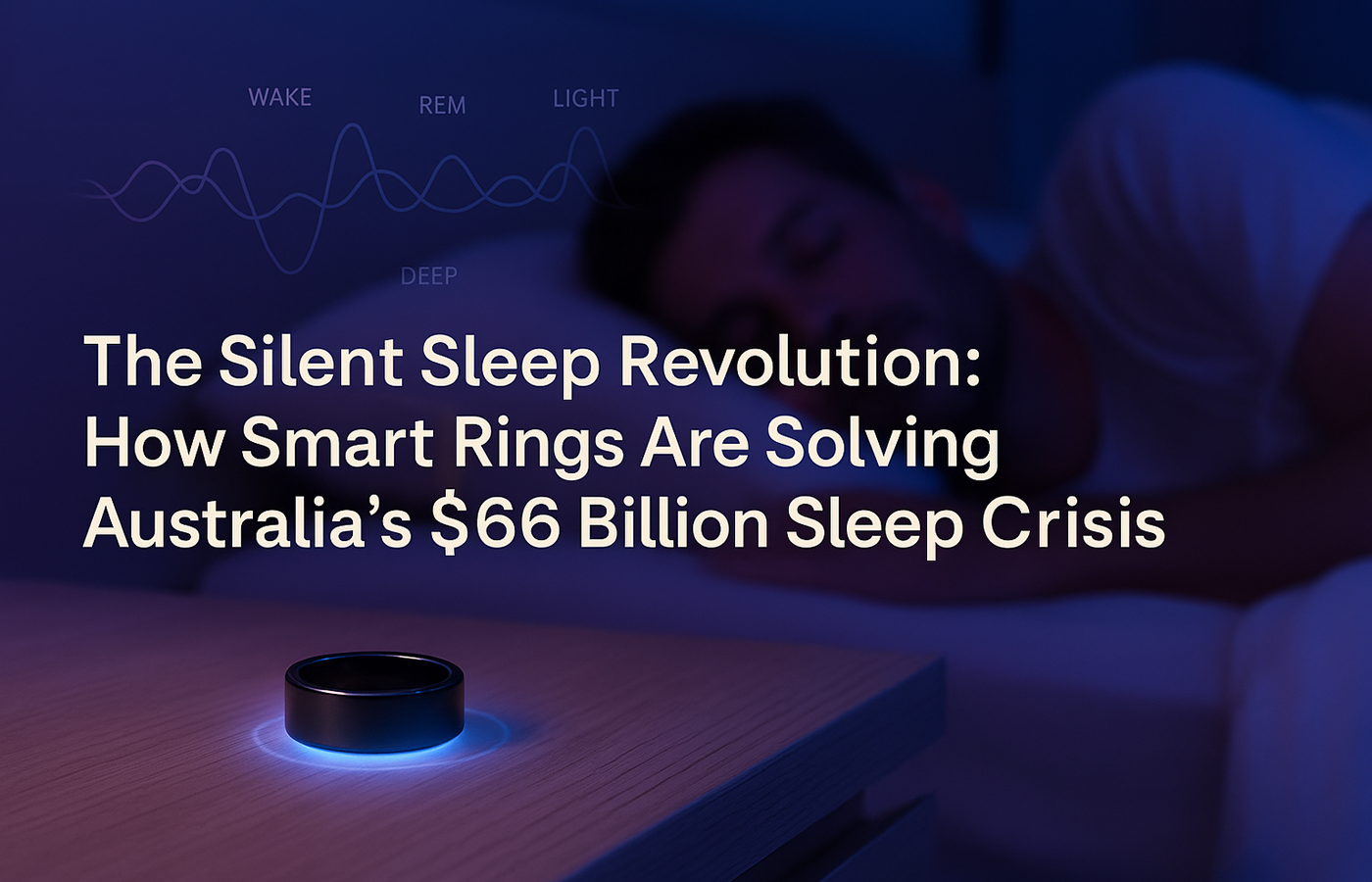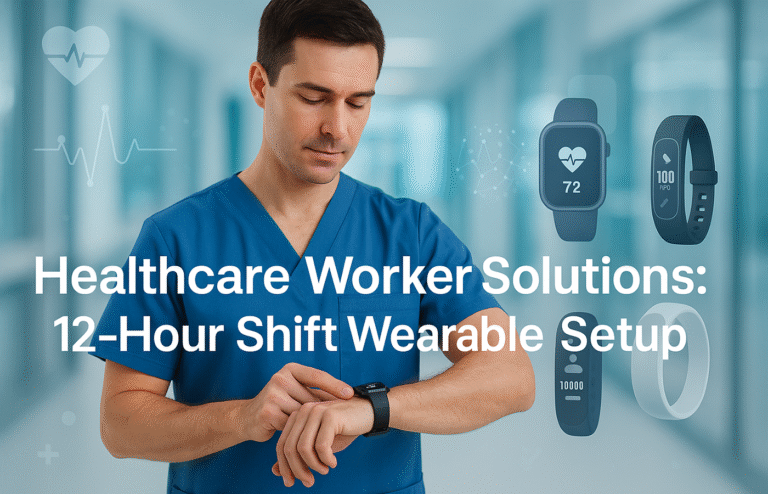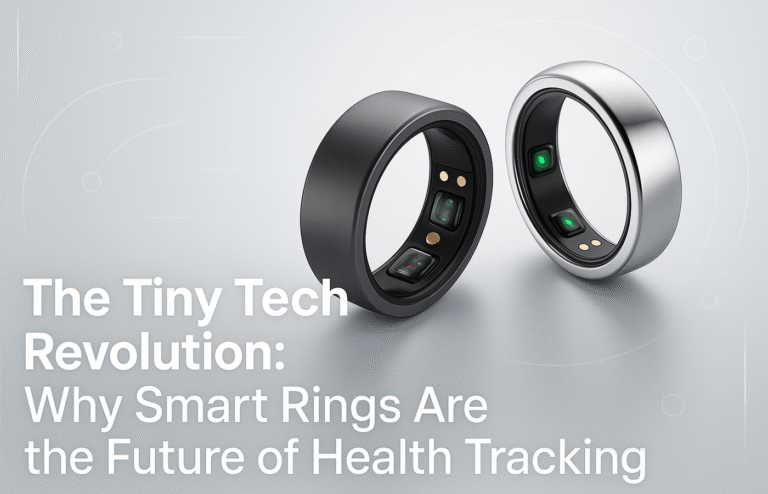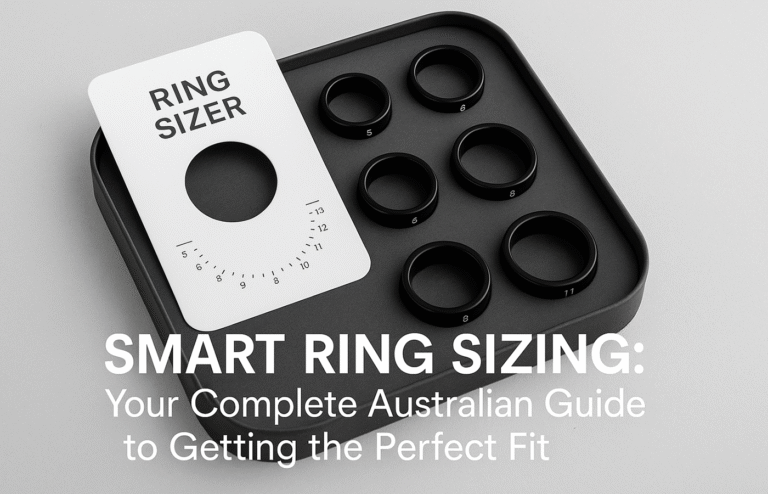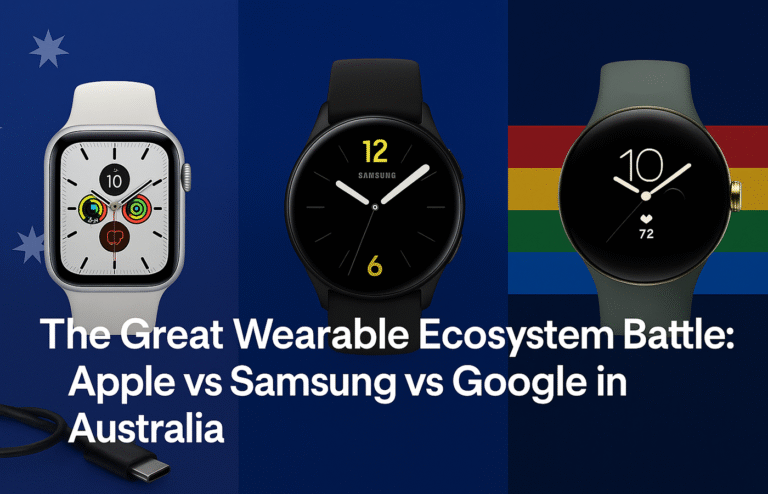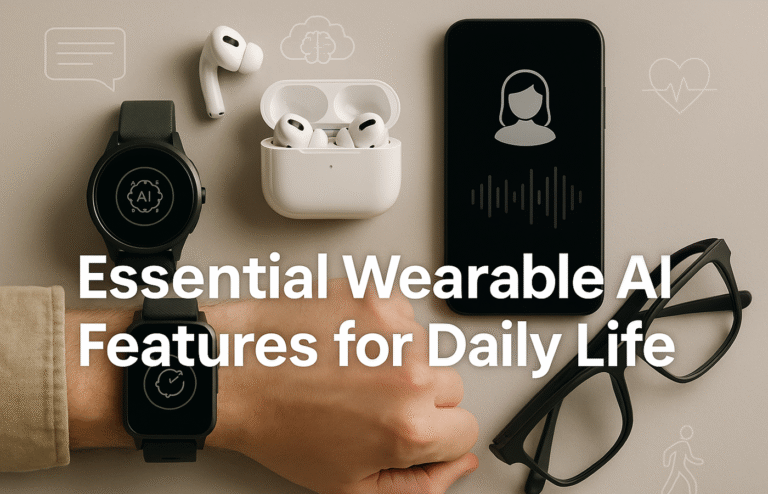The Silent Sleep Revolution: How Smart Rings Are Solving Australia’s $66 Billion Sleep Crisis
Sleep disorders cost Australia $66 billion annually, with 33-45% of adults experiencing inadequate sleep quality.Smart rings offer medical-grade sleep tracking with 85% accuracy compared to clinical studies, revolutionising how Australians monitor and optimise their rest.
Market Leaders:
● Oura Ring Generation 3: $449-549 AUD plus $5.99 monthly subscription
● Samsung Galaxy Ring: $699 AUD with no ongoing subscription fees
Advanced Capabilities:
● Comprehensive sleep stage analysis (Light, Deep, REM sleep tracking)
● Heart rate variability monitoring and personalised sleep coaching
● 24/7 health monitoring beyond sleep metrics
Australian Impact:
Smart rings provide accessible alternatives to $1,500-3,000 clinical sleep studies whilst delivering ongoing insights for improved productivity, health outcomes, and quality of life.
The Silent Sleep Revolution: How Smart Rings Are Solving Australia’s $66 Billion Sleep Crisis
Australia has a sleep problem. While we’re busy perfecting our work-life balance and celebrating our outdoor lifestyle, millions of Australians are struggling with poor sleep quality that’s quietly undermining their daily performance. Recent research reveals that sleep disorders cost the Australian economy approximately $66 billion annually through reduced productivity, workplace accidents, and healthcare expenses. However, a revolutionary solution is emerging from an unexpected source: the humble smart ring.
Unlike the clunky fitness trackers and intrusive smartphone apps of the past, today’s smart rings are transforming how we understand and optimise our sleep. These lightweight, comfortable devices are delivering medical-grade insights that rival clinical sleep studies, all while you sleep peacefully through the night.
Australia’s Hidden Sleep Crisis
The statistics paint a concerning picture of sleep health across Australia. The Sleep Health Foundation reports that 33% to 45% of Australian adults experience inadequate sleep quality or quantity. Moreover, sleep disorders affect one in four Australian children, creating lifelong patterns that continue into adulthood.
This sleep deficit isn’t just about feeling tired the next day. Poor sleep quality directly impacts cognitive function, emotional regulation, immune system performance, and physical health. Furthermore, sleep-deprived employees are significantly more likely to experience workplace accidents, make costly errors, and require sick leave.
The economic impact extends beyond individual health costs. Sleep-deprived workers show reduced creativity, impaired decision-making abilities, and decreased productivity levels that collectively drain billions from the Australian economy each year.
Australian Sleep Statistics Snapshot: According to the Sleep Health Foundation, 59.4% of Australian adults experience at least one chronic sleep symptom, whilst 14.8% experience symptoms of sleep disorders severe enough to warrant clinical intervention. Additionally, sleep problems contribute to 3,017 deaths annually in Australia.
Traditional Sleep Tracking: Why It Falls Short
For years, Australians seeking to understand their sleep patterns had limited options. Traditional methods relied on subjective sleep diaries, which were prone to inaccuracy and recall bias. Meanwhile, early fitness trackers offered basic movement detection that could barely distinguish between lying still and actual sleep.
Smartphone apps attempted to fill this gap by using accelerometers and microphones to monitor movement and sounds. However, these solutions required users to sleep with their phones on the bed, creating potential disruptions from notifications, blue light exposure, and electromagnetic radiation concerns.
Even popular smartwatches, whilst more sophisticated than early trackers, present their own challenges for sleep monitoring. Many users find them uncomfortable to wear overnight, particularly those with larger displays or bulky designs. Additionally, the bright screens can disrupt natural melatonin production if activated during nighttime hours.
These traditional approaches shared a fundamental limitation: they provided surface-level data without deep insights into sleep architecture or actionable recommendations for improvement.
The Smart Ring Revolution: A Game-Changing Approach
Smart rings represent a paradigm shift in sleep monitoring technology. These discreet, lightweight devices pack sophisticated sensors into a form factor that’s comfortable enough to wear 24/7 without disrupting sleep patterns.
The technology behind modern smart rings is remarkably advanced. Multiple sensors work together to capture comprehensive physiological data throughout the night. Photoplethysmography (PPG) sensors monitor heart rate variability and blood oxygen levels, whilst accelerometers and gyroscopes track movement patterns. Advanced temperature sensors detect subtle changes in body temperature that correlate with different sleep stages.
What sets smart rings apart is their ability to correlate multiple data streams simultaneously. By combining heart rate patterns, movement data, and temperature fluctuations, these devices can identify specific sleep stages with remarkable accuracy. This multi-sensor approach provides a holistic view of sleep quality that individual metrics simply cannot achieve.
Comprehensive Sleep Stage Analysis: The Science Behind Smart Rings
Understanding sleep architecture is crucial for optimising rest and recovery. Sleep occurs in distinct stages, each serving specific biological functions. Smart rings excel at identifying and tracking these stages throughout the night.
Light Sleep (NREM Stage 1 & 2) represents the transition period between wakefulness and deeper sleep. During this phase, heart rate begins to slow, and body temperature drops slightly. Smart rings detect these physiological changes through continuous monitoring, accurately identifying when users enter and exit light sleep phases.
Deep Sleep (NREM Stage 3) is perhaps the most critical stage for physical recovery and immune system function. During deep sleep, the body releases growth hormone, consolidates memories, and repairs cellular damage. Smart rings monitor the characteristic slow heart rate patterns and minimal movement that define this restorative phase.
REM Sleep brings vivid dreams and crucial cognitive processing. This stage is essential for memory consolidation, emotional regulation, and creative problem-solving. Smart rings identify REM sleep through distinctive heart rate variability patterns and subtle eye movement detection in advanced models.
By tracking these stages throughout the night, smart rings provide detailed sleep architecture analysis that was previously available only through expensive polysomnography studies in clinical settings.
Technology Breakthrough: Leading smart rings like the Oura Ring Generation 3 (RRP $449-549 AUD) and Samsung Galaxy Ring (RRP $699 AUD) achieve sleep stage detection accuracy rates exceeding 85% when compared to clinical polysomnography, making them viable alternatives to expensive sleep studies for many users.
REM and Deep Sleep Tracking: Why It Matters for Australians
For Australian adults juggling demanding work schedules, family responsibilities, and social commitments, understanding REM and deep sleep patterns can be transformative. These sleep stages directly impact next-day performance, mood regulation, and long-term health outcomes.
REM Sleep Optimisation helps address common Australian lifestyle challenges. Shift workers, who represent a significant portion of the mining, healthcare, and hospitality sectors, can use REM tracking to optimise their irregular sleep schedules. By understanding their natural REM patterns, they can time sleep periods to maximise cognitive recovery even with shortened sleep windows.
Deep Sleep Enhancement becomes particularly valuable for Australian athletes and fitness enthusiasts. Our sports-loving culture means many Australians engage in regular physical activity that demands optimal recovery. Smart rings help users understand how factors like exercise timing, alcohol consumption, and room temperature affect their deep sleep quality.
The data reveals fascinating insights specific to the Australian context. For instance, users often discover how our longer summer daylight hours impact their sleep patterns, or how shift work common in mining regions affects their circadian rhythms.
Personalised Sleep Coaching: Your Digital Sleep Specialist
Perhaps the most valuable feature of modern smart rings is their ability to translate complex sleep data into actionable recommendations. Advanced algorithms analyse individual sleep patterns over time, identifying trends and providing personalised guidance for improvement.
This sleep coaching goes far beyond generic advice. Smart rings learn from your specific patterns, considering factors like age, activity level, and lifestyle habits. They might recommend optimal bedtime windows based on your natural circadian rhythms, suggest pre-sleep routines that enhance deep sleep quality, or identify environmental factors that consistently disrupt your rest.
For example, a smart ring might detect that your REM sleep decreases significantly on nights when you consume alcohol, or that your deep sleep improves when room temperature drops below 18°C. These personalised insights enable targeted interventions that generic sleep advice simply cannot provide.
The coaching aspect extends to wake-up timing as well. Rather than jarring you awake during deep sleep, smart rings can identify optimal wake windows during lighter sleep phases, helping you feel more refreshed and alert throughout the day.
Australian Market Leaders: Oura vs Samsung Galaxy Ring
The Australian smart ring market currently features two primary players, each offering distinct advantages for local consumers.
The Oura Ring Generation 3 has established itself as the gold standard for sleep tracking accuracy. Available in Australia through authorised retailers, the Oura Ring offers comprehensive sleep analysis, detailed recovery metrics, and integration with popular health platforms. The subscription model (approximately $5.99 AUD monthly) provides ongoing algorithm improvements and detailed health insights.
Samsung Galaxy Ring represents the tech giant’s entry into the wearable ring market. Launched in Australia in 2024, it offers seamless integration with Samsung Health and Galaxy ecosystem devices. The lack of subscription fees appeals to cost-conscious consumers, whilst the familiar Samsung interface provides easy adoption for existing Galaxy users.
Both devices excel in sleep tracking accuracy, though they differ in approach. The Oura Ring focuses heavily on recovery metrics and long-term health trends, whilst the Galaxy Ring emphasises real-time insights and ecosystem integration.
Australian Pricing Comparison: The Oura Ring Generation 3 starts at $449 AUD for the Heritage model and $549 AUD for the Horizon model, plus ongoing subscription costs. The Samsung Galaxy Ring retails for $699 AUD with no subscription fees, making it more expensive upfront but potentially more economical over time for users who maintain devices for several years.
Beyond Sleep: Comprehensive Health Monitoring
Whilst sleep tracking represents the primary use case, smart rings offer comprehensive health monitoring that extends throughout the day. This 24/7 approach provides context that enhances sleep insights and overall health understanding.
Heart Rate Variability (HRV) monitoring helps users understand their autonomic nervous system function and recovery status. Poor HRV scores often correlate with inadequate sleep quality, creating a feedback loop that helps optimise both rest and daily stress management.
Activity Tracking complements sleep data by showing how daily movement patterns affect nighttime rest. Users can identify optimal exercise timing that enhances rather than disrupts their sleep quality.
Temperature Monitoring provides insights into circadian rhythm health and can identify early signs of illness or hormonal changes that might affect sleep patterns.
This comprehensive approach means smart rings become health monitoring platforms rather than single-purpose devices, providing exceptional value for health-conscious Australians.
Making the Investment: Cost vs. Value Analysis
When considering a smart ring purchase, Australian consumers should evaluate the long-term value proposition beyond the initial cost. A clinical sleep study in Australia can cost between $1,500-3,000 AUD and provides only a single night’s data. In contrast, smart rings deliver ongoing sleep monitoring and coaching for years.
The health benefits extend to reduced healthcare costs through better sleep hygiene, improved productivity at work, and enhanced quality of life. Many users report significant improvements in energy levels, mood stability, and cognitive performance within weeks of beginning comprehensive sleep tracking.
For families, the investment becomes even more compelling. Multiple family members can use compatible devices, creating a comprehensive household health monitoring system that identifies patterns and promotes better sleep habits for everyone.
The Future of Sleep Technology in Australia
The smart ring market continues evolving rapidly, with new features and capabilities emerging regularly. Advanced sensors are becoming smaller and more accurate, whilst battery life improvements mean less frequent charging interruptions.
Integration with Australia’s healthcare system represents an exciting frontier. Some private health insurers are beginning to recognise wearable device data for wellness programmes, potentially reducing premiums for users who demonstrate healthy sleep patterns.
Research partnerships between smart ring manufacturers and Australian universities are exploring applications for shift worker health, sleep disorder screening, and population health monitoring that could benefit millions of Australians.
Taking Action: Your Sleep Revolution Starts Tonight
The evidence is clear: smart rings represent the most practical, accurate, and comprehensive solution for understanding and improving sleep quality available to Australian consumers today. Whether you’re a shift worker struggling with irregular schedules, an athlete seeking optimal recovery, or simply someone tired of feeling tired, these devices offer actionable insights that can transform your sleep experience.
The investment in a quality smart ring pays dividends through improved health, enhanced daily performance, and better quality of life. As Australia continues grappling with the economic and personal costs of poor sleep, smart rings provide a practical, accessible solution that puts the power of sleep optimisation literally at your fingertips.
Your journey to better sleep doesn’t require expensive clinical studies or complex lifestyle overhauls. It starts with understanding your unique sleep patterns and receiving personalised guidance to optimise them. The technology exists today, the benefits are proven, and the solution is as simple as slipping a ring on your finger before bed.
The sleep revolution is here, and it’s time for Australians to embrace it.

